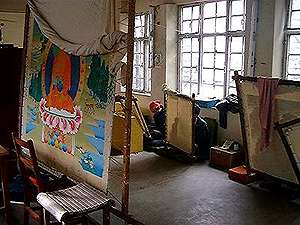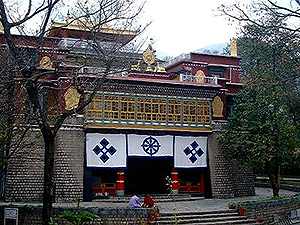|
Following
Gandhi's Path - Part 3
Tibet
- Culture In Exile
By Jan
Oberg
TFF director
Everyone driving must turn around at the bus and cab
station. Dharamsala is actually car-free, peaceful,
chaotic and characterised by an astounding pioneering
spirit. The street scene is dominated by monks in
wine-red clothes and a remarkably great number of beggars
with leprousy. On this dangerous, Himalayan slope,
fantastic architectural constructions, often hotels, are
being built. But they are said to collapse quicker than
they have been built, when heavy rains or glacier-melt
water come down in torrents.
Everything is beautiful around here, except the trees.
It is forbidden to cut down their very trunk, but
everywhere people have climbed up and chopped off all
their limbs. After all, they need firewood. Power cuts
happen on a daily basis and, of course, electricity is
rationed - except when the governor of the federal state
of Himachal Pradesh, to which Dharamsala belongs,
descends on his subjects for an official visit. At those
times water and electricity is available around the
clock. Apparently he is not supposed to get an
excessively realistic picture of the local peoples'
everyday life!
There are different ways to meet the Dalai Lama. When
he is at home, you can just go up to his flat in the
temple block and seek an audience with him. If you come
to McLeod in March, he is giving his "teachings" to
thousands of listeners, many of them Tibetans for whom he
is nothing less than god. Unfortunately, my visit
happened to take place during his annual three-week
"retreat" in February when he does not receive visitors.
My friends told me that they felt as if they were
floating some five to seven centimetres above the ground
after having met him personally some weeks earlier.
There are lots of things worth seeing in this
beautiful region: small ecological cooperatives, shops
selling health-care medicine and handmade paper,
spiritual book stores, and exquisite restaurants ranging
from the plainest to Chonor House, the exclusive hotel
with a view over McLeod. In the latter is served the best
of Tibetan cuisine whilst monkeys swing from tree to tree
and sometimes even throw themselves down on the tables in
a Kamikaze-like manner.
The Tibetan Museum of McLeod is dedicated to
the history of Tibet focussing on the fate of the exiled
Tibetans. It is a beautiful and simple museum, which can
also be found on the Internet: http://www.thetibetmuseum.org/
Downstairs in the government quarters you can find the
Library of Tibetan Works and Archives, an
extensive collection of books and periodicals that
contains 40 % of all Tibetan writings by hand. On the
first floor of this temple-like building is situated the
Tibetan Cultural Museum, where I became fascinated with
the collection of tangkas.

Photo Jan Öberg, © TFF
2001
Tangka paintings at
Norbulinka
No, they're not underwear. These are sacred Buddhist
paintings on cotton canvas made with a technique that is
somewhat reminiscent of tempera. The details are so
minute that you need a magnifying glass to see them. The
tangka is also a multicoloured, harmonious composition in
front of which people stand whilst praying or meditating.
They often have a naturalistic motif or depict some
historic event - the Wheel of Life or the Buddhist gods
and fantastic figures from the Tibetan mythology. Another
category is mandhalas, which always have severely
geometric or non-figurative motifs with a central point
that one is expected to concentrate intensely upon, maybe
even get lost in.
The finest tangkas and mandhalas are usually framed by
a large passe-partout of silk or silk brocade. They hang
on transverse pegs. In front of the painting with its
silk frame is a covering cloth, which protects the tangka
when it is being rolled up or moved around from temple to
temple or carried around by its owner. This fascinating
form of art has been described by, among others, Anjan
Chakraverty in Sacred Buddhist Painting, Lustre
Press, New Delhi, 1998. Illustrated examples can also be
found at, for example,
http://www.iol.ie/~taeger/thkas/thgk-gal.html.

Photo Jan Öberg, © TFF
2001
One of the many
centres in Norbulinka
Visit the Norbulinka Institute! You can start
with the Internet (http://www.tibet.net/eng/norling/)
but it is much better if you travel there! Once there,
one believes that one has come to a Japanese garden, with
large stones, plants, pavilions, cafeterias, hotels,
conference centres, etc. There are murmuring brooks,
varying types of architecture, temples, and workshops for
textiles, clothes, wooden products, handicrafts, dolls,
paintings, embroidery, wood engravings, goldsmiths, and
so on. Tibetan cultural workers are educated at
Norbulinka. The skills and traditions of the (exiled)
culture are being kept alive and innovations are
thriving. I have seldom seen such stylish, super-modern
shirts and jackets, nor such lovely silk fabrics and home
furnishing articles.
Norbulinka's varying exhibitions and pavilions contain
a conglomeration of the arts and crafts' school, the
academy of fine arts, the design centre, the art gallery,
the temple and the place for meditation. You can walk
straight through and come out on the other side. I leave
this Tibetan oasis behind me through a small gate and
enter an Indian village where pretty young farm-girls
smile shyly at the stranger with a camera. Here can be
found cows, goats, monkeys, clay huts, fences with
artfully arranged haystacks - a picturesque idyll with
the only negative being an old, faded sign which says
that once there was a World Bank project at this place.
Fortunately, the bank failed to destroy this village with
its "development" philosophy.
Dharamsala and Norbulinka give witness to the great
life and cultural expression of an oppressed people. No
one, not even Westerners or the Chinese, could possibly
ever destroy it.
Translated by Alice
Moncada
Translation edited by Sara E. Ellis
Other
articles about India, "Following Gandhi's Path", and
picture galleries
©
TFF 2002

Tell a friend about this article
Send to:
From:
Message and your name
|